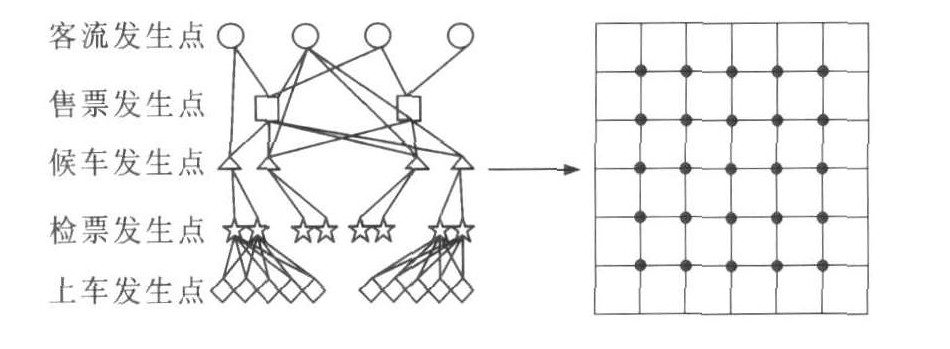Microscopic simulation model of passenger mustering and evacuation in passenger dedicated railway station
Article Text (Baidu Translation)
-
摘要: 为优化铁路客运专线车站的设计, 研究了考虑不同发车频率的客流生成机制, 应用标准的马尔可夫决策过程描述了乘客在车站内的集散过程, 提出了基于逻辑网络和点阵的设备控制表示方法, 建立了铁路客运专线车站乘客集散微观仿真模型。仿真发现: 当行人移动空间在0.5m 2左右时, 流量达到峰值, 速度分布在20~80m·min -1, 并随密度增加呈指数递减趋势; 在相同客流输入条件下, 不同设施上的客流集散规律不同; 通过对行人复杂行为的仿真, 成功再现了客流集散中的自组织现象, 有效避免了交通流基本图模拟现实交通中的不适应取值范围。结果表明模型具有较高的可靠性和实用性。Abstract: In order to optimize the design of passenger dedicated railway station, the mechanism of passenger flow generation was studied, passenger mustering and evacuation process was described by using a standard Markov decision process, a method of facility control based on logical network and point matrix was presented, and a microscopic simulation model of passenger mustering and evacuation was proposed for passenger dedicated railway station. Simulation result shows that the maximum flow appears when passenger space is about 0.5 m2, the speed distributes between 20 m·min-1 and 80 m·min-1 and increases exponentially with density. Passenger patterns are different according to facility types despite of the same passenger flow input. The simulation of passenger behavior reproduces the self-organization phenomenon successfully, and avoids the inapplicable data sample range of traffic flow fundamental diagram. So the model is reliable and practical.
-
[1] DAANEB W. Modeling passenger flows in public transport facilities[D]. Delft: Delft University, 2004. [2] 何宇强, 毛保华, 丁勇. 铁路客运站最高聚集人数模拟计算研究[J]. 系统仿真学报, 2006, 18(1): 213-217. doi: 10.3969/j.issn.1004-731X.2006.01.054HE Yu-qiang, MAO Bao-hua, DI NG Yong. Research on si mulative calculation of maxi mumassembling of rail way pas-senger station[J]. Journal of System Si mulation, 2006, 18(1): 213-217. (in Chinese) doi: 10.3969/j.issn.1004-731X.2006.01.054 [3] TEKNOMO K. Microscopic pedestrian flow characteristics: development of ani mage processing data collection and si mu-lation model[D]. Tohoku: Tohoku University, 2002. [4] DAAMEN WS P H. Controlled experi ments to derive walk-ing behavior[J]. European Journal of Transport Infrastruc-ture Research, 2003, 3(1): 39-59. [5] HELBI NG D, BUZNA L, JOHANSSON A, et al. Self-organized pedestrian crowd dynamics: experi ments, si mula-tions, and design solutions[J]. Transportation Science, 2005, 39(1): 1-24. doi: 10.1287/trsc.1040.0108 [6] 李得伟. 城市轨道交通乘客集散模型及微观仿真理论研究[D]. 北京: 北京交通大学, 2007. [7] 李得伟, 韩宝明, 张琦. 基于动态博弈的行人交通微观仿真模型[J]. 系统仿真学报, 2007, 19(11): 2590-2593. doi: 10.3969/j.issn.1004-731X.2007.11.052LI De-wei, HAN Bao-ming, ZHANG Qi. Modeling and si mu-lation of microscopic pedestrian using game theory[J]. Journal of SystemSi mulation, 2007, 19(11): 2590-2593. (in Chinese) doi: 10.3969/j.issn.1004-731X.2007.11.052 [8] 李得伟, 韩宝明, 韩宇. 一种逆向改进型A*路径搜索算法[J]. 系统仿真学报, 2007, 19(22): 5175-5177, 5213. doi: 10.3969/j.issn.1004-731X.2007.22.018LI De-wei, HAN Bao-ming, HAN Yu. Conversely i mproved a star route search algorithm[J]. Journal of System Si mula-tion, 2007, 19(22): 5175-5177, 5213. (in Chinese) doi: 10.3969/j.issn.1004-731X.2007.22.018 [9] LI De-wei, HAN Bao-ming. Modeling and si mulation pedes-trian evacuation processin mass transit rail way stations[C]//Huang Ping. Progress in Safety Science and Technology. Beijing: Science Press, 2006: 365-370. [10] 李得伟, 韩宝明, 鲁放. 基于多智能体的交通枢纽微观仿真研究[J]. 都市快轨交通, 2006, 19(5): 48-52. https://www.cnki.com.cn/Article/CJFDTOTAL-DSKG200605019.htmLI De-wei, HAN Bao-ming, LU Fang. Microscopic si mula-tion of traffic hub based on multi-agent[J]. Urban Rail way Transit, 2006, 19(5): 48-52. (in Chinese) https://www.cnki.com.cn/Article/CJFDTOTAL-DSKG200605019.htm [11] BLUE VJ. Cellular automata microsi mulation of bi-directional pedestrian flows[R]. Washiugton DC: TRB, 2000. [12] WIGGENRAAD P B L. Alighting and boarding ti mes of pas-sengers at Dutch rail way stations[R]. Delft: Trail Research School, 2001. -





 下载:
下载:








